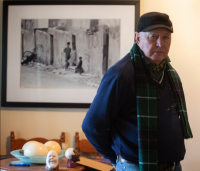It is with regret that the Nelson Mandela Foundation has received news of the passing of South African photographer Cloete Breytenbach earlier this month.
While his iconic photograph of Nelson Mandela and Walter Sisulu, taken around July of 1964 on Robben Island, is known the world over, Breytenbach was not often credited for this work. We are grateful that in recent years he granted permission to the Nelson Mandela Foundation to use these photographs free of charge in an exhibition and on our website.

In an interview with the Foundation’s Senior Researcher on 30 June 2013 he spoke of how in 1964 he came to take that photograph and others on Robben Island. He was asked by the Daily Express syndication service to accompany John Rydon, a reporter they were sending from London, to do a story on Nelson Mandela, who had been sentenced to life imprisonment for sabotage on the 12th of June that year.
“When we got there, they were all sitting in this courtyard, the prisoners, and I could make out Mandela and Sisulu – they were sitting in three or four rows breaking stones with a little hammer, you see?”
He was permitted to go down to the courtyard as long as he did not speak to them.
In his autobiography, Long Walk to Freedom, Mandela explained how they were made to sit on the concrete, crunching the stones for hours every day: “We were divided into four rows, about a yard-and-a-half apart, and sat cross-legged on the ground. We were each given a thick rubber ring, made from tyres, in which to place the stones.”
Breytenbach recalled the moment he went to the courtyard: “I said, ‘Good morning’ and they said, ‘Good morning’. Everybody continued chipping away.”
He said he shot three rolls of 35mm film – about 90 frames that morning – and that the negatives were being held in a safe place. His photographs were published all over the world except in South Africa where it was then illegal to publish the image of a prisoner and certainly not of Mandela and his comrades.
Cloete Breytenbach has left a valuable body of work, particularly on our recent history in South Africa. We send our deepest condolences to his family and friends.